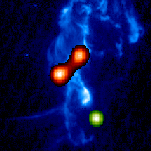RHESSI Hard X-ray Imaging
RHESSI does imaging spectroscopy, which means that it can determine the source spectrum at every image point. The movie below shows one way of looking at this complicated kind of data; it shows the time development of one of the X-class flares of December 2006, contrasting TRACE UV images with RHESSI soft X-ray and hard X-ray images. Each band seems to tell a different story about the flare development, but the hard X-rays (green sources in the movie) provide the best guide to the actual energy release that drives the entire process.

|
| A movie showing the development of the flare of December 6, 2006. The blue background images are from the TRACE spacecraft, and the red and green brightenings show RHESSI soft and hard X-rays, respectively. Click on the image to download/play the entire movie, but note that it is a large file (38MB mpeg). An alternative Javascript movie is also available. |
The movie frames show a small fraction of the area of the solar disk. The visible structures are thought to reveal the presence of intense magnetic fields, strong enough in fact to dominate the forces within the flare or CME. These energetic events have relative small scales (100,000 km, some 15 times the Earth's radius). The very energetic parts seen by RHESSI have (as shown) smaller scales still.